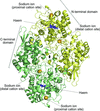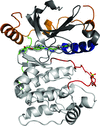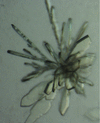issue contents
March 2014 issue

Cover illustration: 2.2 Å resolution structure of the USP7 catalytic domain (Molland et al., p. 283)
IYCr crystallization series
The properties of the mesoscopic protein-rich clusters, within which protein crystal nuclei form, are reviewed. The cluster populations occupy from 10−7 to 10−3 of the solution volume; the cluster radii are of order 100 nm; the clusters exist owing to the formation of transient oligomers that, for some proteins, may be due to conformational flexibility.
structural communications
New crystallization conditions for the catalytic domain of human ubiquitin specific protease 7 (USP7CD) were found that produced crystals in space group C2 with one molecule in the asymmetric unit which is an advantage over previous crystallization conditions of USP7CD which produced crystals in space group P21 with two molecules in the asymmetric unit. Comparison of the refined structure of USP7CD in space group C2 with that of P21 suggests that conformational rearrangement of blocking loop residues 410–419 must occur in order for ubiquitin to bind and that the catalytic triad and switching loop region are in the same catalytically unproductive conformations as in the P21 structure in the absence of ubiquitin.
The crystal structure of the catalase-peroxidase KatG from S. elongatus PCC 7942 was determined at 2.2 Å resolution.
PDB reference: KatG, 3wnu
Open  access
access
 access
accessTwo structures of Aurora B kinase bound to the specific inhibitor barasertib and to a nonhydrolyzable nucleotide provide evidences for a potential transinhibitory mechanism.
Open  access
access
 access
accessA co-crystal structure of human farnesyl pyrophosphate synthase in complex with an aminopyridine bisphosphonate, YS0470, and two molecules of inorganic phosphate has been determined. The identity of the phosphate ligands was confirmed by anomalous diffraction data.
Open  access
access
 access
accessThe structure of a new crystal form of IgE-Fc in complex with its B-cell receptor CD23 has been determined. The structure reveals that there is conformational variability at the interface in both IgE-Fc and CD23.
PDB reference: CD23–Fc∊3-4 complex, 4ki1
crystallization communications
Open  access
access
 access
accessThe amidase domain of the allophanate hydrolase AtzF from Pseudomonas sp. strain ADP has been crystallized and preliminary X-ray diffraction data have been collected.
β-Ketothiolase B from R. eutropha, an enzyme involved in polyhydroxyalkanoate synthesis, has been crystallized and X-ray diffraction data have been collected from the crystal and analyzed.
The purification, crystallization and preliminary crystallographic analysis of the catalytic core of cystathionine β-synthase (CBS) from Saccharomyces cerevisiae is reported.
Native and SeMet-labelled FleQ domains of S. maltophilia were crystallized and diffracted to resolutions of 2.08 and 2.58 Å, respectively.
Pectin methylesterase from S. levis was produced, purified and crystallized. This is the first report of an X-ray diffraction study of a recombinant pectinase of animal origin.
Immunity protein TsiV3 from Vibrio cholera has been expressed, purified and crystallized. The crystal belonged to space group P212121, with unit-cell parameters a = 73.3, b = 78.12, c = 106.18 Å and diffract to 2.55 Å resolution.
A truncated form of AmbB from Pseudomonas aeruginosa that contains a phosphopantetheine binding (PB) domain and a condensation domain has been crystallized and diffraction data were collected to 2.45 Å resolution.
The C-terminal Src homology 3 domain of human Tks4 (residues 853–911) was expressed, purified and crystallized, and X-ray diffraction data were collected to 2.3 Å resolution.
Crystals of T. thermophilus IDI-2 obtained under anaerobic conditions (<5 p.p.m. O2) will be useful in understanding the active-site conformation of the reduced flavin cofactor.
The crystallization and preliminary X-ray diffraction analysis of the catalytic domains of cell-surface-expressed chitinase ChiW from Paenibacillus sp. strain FPU-7 are reported.
Open  access
access
 access
accessThe C-terminal kinase domain of TLK2 (a human tousled-like kinase) has been cloned and overexpressed in Escherichia coli followed by purification to homogeneity. Crystallization experiments in the presence of ATP-γ-S yielded crystals suitable for X-ray diffraction analysis belonging to two different space groups: tetragonal I4122 and cubic P213.
The soluble extracellular fragment of the interleukin-3 alpha receptor (IL3Rα) was complexed with the Fab fragment of antibody CSL362 and crystals of the IL3Rα–CSL362 complex were obtained. These crystals belonged to the monoclinic P21 space group and diffracted to 2.8 Å resolution at the Australian Synchrotron.
BamA is a central component of the β-barrel Assembly Machinery complex, and the transmembrane domain of BamA from E. coli is refolded and crystallized at 2.6 Å resolution.
The expression, purification, crystallization and preliminary crystallographic characterization of the diterpene cyclooctatin synthase (CYC) from Streptomyces sp. LZ35 are reported.
The 33 kDa haemagglutinin subcomponent of the botulinum toxin complex of the unique strain of serotype C Clostridium botulinum was crystallized and X-ray diffraction data were collected to 2.2 Å resolution.
In order to understand the molecular basis of action of the Alzheimer's disease passive immunotherapy candidate bapineuzumab, the Fab fragment of this antibody was crystallized in complexes with Aβ peptides. The best crystals diffracted to a resolution of 2.0 Å (Aβ residues 1–8) and 2.2 Å (Aβ residues 1–28).
laboratory communications
A combination of secondary-structure and solvent-accessibility predictions for methionine substitution is a useful method in SAD and MAD phasing


 journal menu
journal menu


































![[publBio]](/logos/publbio.gif)





